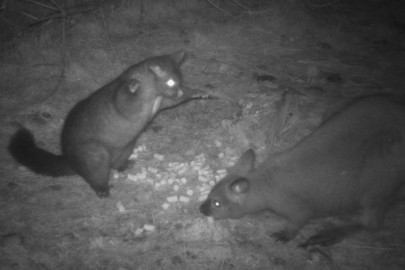
A complex interspecies interaction is caught on camera as the smaller possum scares off the bigger wallaby.
Wallabies are up to four times heavier than possums, but during the different baiting trials conducted by Manaaki Whenua, battles played out over food piles. Cameras captured the action as possums aggressively fought off wallabies. Standing on their hind legs, they clawed and pounced at the larger species, forcing the wallabies to retreat until the possums had their fill.
Graham says interspecific competition is a powerful force in nature. “Animals compete aggressively for resources, such as food, and the winners of these interactions get to dominate the resource.”
Which is bad news for wallaby management efforts.
“The challenge for farmers in wallaby-affected areas is that stocking rates are dropping under sustained pressure from wallabies, but to remove wallabies you must first knock down the possum numbers, as they will dominate the toxic bait,” says Patrick. The obvious management problem is that wallabies won’t gain access to baits until local possums have had their fill, increasing the costs and amount of labour required.
Possums are also messy eaters, so they leave bait on the ground around the bait station. Wallabies eat these partial pellets but in reduced sub-lethal quantities that could potentially generate taste-aversion conditioning that lasts a lifetime. This would create a bait-shy group of survivors that can repopulate an area.
“The issue of possum interference not only leads to primary sector production losses, but results in biodiversity losses, where managers struggle to control wallabies in native forests due to interference by possums,” says Patrick.
Graham adds that effective management of invasive species through bait stations may require more sophisticated strategies that consider these behavioural interactions. “This might include designing feeders that minimise possum interference, or scheduling feeding times that align better with wallaby feeding patterns,” he says.
This is a good example of how interspecific competition by one dominant species can undermine control of a second. Animal behaviours and interactions fundamentally influence management outcomes, so understanding this behaviour is crucial to successful pest eradication.
Key contact

